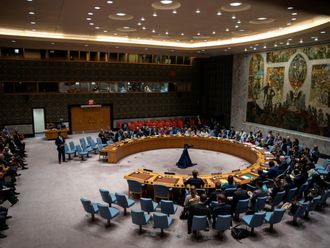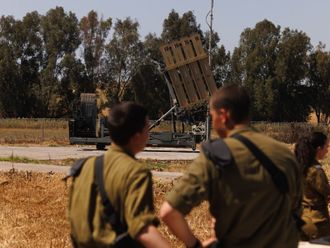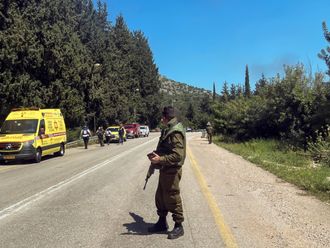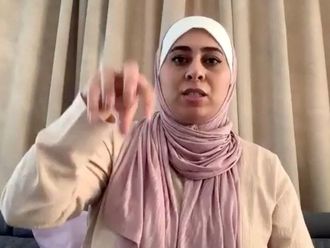
VIENNA: The historic nuclear accord between Iran and major powers entered into force Saturday and painful sanctions on the Islamic republic were lifted as the UN confirmed that Tehran has shrunk its atomic programme.
The International Atomic Energy Agency said its "inspectors on the ground verified that Iran has carried out all measures" agreed under the July 14 agreement.
EU foreign policy chief Federica Mogherini, representing the six powers, said that as a result "multilateral and national economic and financial sanctions related to Iran's nuclear programme are lifted".
"All sides remain firmly convinced that this historic deal is both strong and fair, and that it meets the requirements of all," Mogherini said in Vienna in a joint statement with Iranian Foreign Minister Mohammad Javad Zarif.
"This achievement clearly demonstrates that with political will, perseverance, and through multilateral diplomacy, we can solve the most difficult issues and find practical solutions that are effectively implemented," they said.
The so-called "Implementation Day" for the accord also followed news of a prisoner swap between Iran and the United States in another sign of thawing relations between the two foes since the July 14 agreement.
The steps taken by Iran, combined with ultra-close IAEA inspections, extend to at least a year - from a few months previously - how long Iran would need to make one nuclear bomb's worth of fissile material.
They include slashing by two-thirds its uranium centrifuges, reducing its stockpile of uranium - enough before the deal for several bombs - and removing the core of the Arak reactor which could have given Iran weapons-grade plutonium.
Iran has always denied wanting nuclear weapons, saying its activities are exclusively for peaceful purposes such as power generation.
In what was hailed as a momentous diplomatic breakthrough, the Vienna agreement was nailed down after two years of rollercoaster negotiations following the June 2013 election of Iranian President Hassan Rouhani.
United Nations
The United Nations Security Council received on Saturday a report by the UN nuclear watchdog confirming Iran fulfilled commitments under a nuclear deal with world powers, triggering an automatic end to most UN sanctions, diplomats said.
The receipt of the International Atomic Energy Agency (IAEA) report by the 15-member council terminates seven previous UN resolutions, which are now replaced by a resolution adopted on July 20 that carries over some UN restrictions.
US lifts Iran sanctions
The United States implemented its side of the Iran nuclear deal Saturday, lifting a raft of sanctions imposed on Tehran to rein in its weapons program.
Secretary of State John Kerry was in Vienna to receive a report from the UN nuclear watchdog certifying that Iran had honored its side of the bargain.
Under authority delegated to him by US President Barack Obama, he signed documents confirming the US government had received the report and waivers to implement the lifting of US Congressional sanctions.
"I hereby confirm that the International Atomic Energy Agency has verified that Iran has fully implemented its required commitments... The US sanctions-related commitments... are now in effect," Kerry said.
Separately, in Washington, Obama signed an order revoking previous executive orders imposing further sanctions beyond the scope of the Congressional sanctions.
Sanctions lifted: EU's Mogherini
Multinational and national nuclear-related sanctions on Iran are lifted following Tehran's compliance with July's atomic deal with major powers, European Union foreign policy chief Federica Mogherini said.
"As Iran has fulfilled its commitments, today, multilateral and national economic and financial sanctions related to Iran's nuclear programme are lifted in accordance" with the July deal, Mogherini said in Vienna.
Rouhani says nuclear deal a 'glorious victory'
Iran's President Hassan Rouhani said Saturday's implementation of a nuclear deal with world powers was a "glorious victory" for the "patient nation of Iran."
In comments posted on his official Twitter account, he wrote: "I thank God for this blessing & bow to the greatness of the patient nation of Iran. Congrats on this glorious victory!"
Timeline of Iran's nuclear crisis
VIENNA: Here is a summary of the main developments in the 13-year standoff between Iran and the West over Tehran's disputed nuclear programme.
2002-2004: Undeclared sites
In 2002 the existence of undeclared nuclear facilities at Natanz and Arak is revealed. Iran invites the International Atomic Energy Agency (IAEA) to carry out inspections and says its activities are peaceful. In 2003, Iran agrees with Britain, Germany and France to suspend suspect activities but the following year goes back on the pledge. In 2004, the IAEA says it found no evidence of a secret weapons drive but cannot rule out undeclared materials. In Paris talks, Iran again agrees to suspend certain activities.
2005-2008: Escalation and enrichment
In August 2005, under a hardline president, Mahmoud Ahmadinejad, Tehran produces uranium gas, the precursor to enrichment for providing the core material for a bomb. European nations break off negotiations.
In 2006, Iran breaks IAEA seals on the Natanz enrichment facility and begins enrichment. The IAEA refers Iran to the UN Security Council, which in July passes the first of seven resolutions.
In August, Ahmadinejad inaugurates a heavy water plant at Arak, raising fears Iran might be seeking weapons-grade plutonium.
December's second UN Security Council resolution comes with sanctions attached. The US and EU follow suit.
By November 2007, Iran says it has at least 3,000 centrifuges, which in theory would allow it to produce enough enriched uranium for a nuclear bomb in less than a year. In 2015 it had almost 20,000, of which half were active.
2009-2012: Advances and allegations
In September 2009, US, French and British leaders announce Iran is building an undeclared enrichment site at Fordo, built into a mountain near Qom.
In October, Iran agrees to swap low-enriched uranium for reactor fuel. But the deal unravels and in February 2010 Iran begins enriching uranium to close to bomb-grade - providing isotopes for medical use, it says.
In 2011, the Russian-completed Bushehr power reactor - first begun by Germany's Siemens - begins operating.
In November 2011, an IAEA report, collating "broadly credible" intelligence, says that at least until 2003 Iran "carried out activities relevant to the development of a nuclear explosive device".
The following month the US Congress passes legislation sanctioning lenders who deal with Iran's central bank.
In January the EU bans all member states from importing Iranian oil. Israeli Prime Minister Benjamin Netanyahu, whose country is widely assumed to have nuclear weapons, brandishes a diagram of a bomb at the UN General Assembly, calling for a "clear red line" to be drawn under Iran's programme.
2013: Interim accord
Newly-elected Iranian President Hassan Rouhani vows in 2013 he is ready for "serious" negotiations.
After secret negotiations in Oman between US and Iranian representatives, Rouhani and US President Barack Obama have an unprecedented phone conversation.
In November an interim deal is agreed freezing some of Iran's nuclear activities in exchange for minor sanctions relief. Two deadlines - July and November 2014 - to agree a final deal are missed. In April 2015, Iran and major powers agree in Lausanne, Switzerland the main outlines of a final deal.
2015: "Historic" accord
On July 14 the historic accord is finally concluded in Vienna, ending 12 years of crisis and 21 months of protracted negotiations.
The accord provides Tehran relief from crippling economic sanctions in exchange for limits on its nuclear programme.
In mid-December the IAEA draws a line under a long-running probe into Iran's past efforts to develop nuclear weapons, removing an important obstacle to implementing the July deal.
2016: Implementing the deal
January 14: Iran says it has removed the core of its Arak heavy water reactor and filled part of it with concrete, paving the way for UN nuclear inspectors to announce Tehran has met its commitments.
January 16: The International Atomic Energy Agency confirms that Iran has "carried out all measures required under the (July deal)... to enable Implementation Day to occur."











